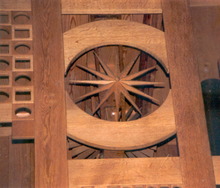Zimbelstern

Zimbelstern or Cymbelstern is an effect register in organs . Zimbelsterne can be detected since the 15th century. They are particularly common in baroque organs. There are also instruments with two or three cymbal stars.
Components and functionality
A Zimbelstern is an effect register that usually consists of two components: a sounding play mechanism and up to three rotating stars made of metal or painted wood. The mechanism consists of a small number of bells, bowl bells or chime sticks, the cymbals . It is usually located inside the organ, i.e. H. is not visible from the outside.
The second component of the effect register is the actual Zimbelstern in the prospectus connected to the musical mechanism . Only the star is visible to the outside. Some organs have several visible stars, which are either all connected to the same mechanism inside the organ or each with its own mechanism.
The Zimbelstern is started up from the organ console, using a special switch or its own register, or a foot switch.
If the register is activated, the cymbals can be heard from the organ, while the star rotates visibly towards the outside.
The sound propagates in a straight line if it is not bent at an obstacle. The intermittent coverage of small sound sources by the arms of the rotating star from the listener's point of view results in a volume modulation, a vibrato .
Types and drive

There are different types and designs for such an effect register.
Cymbals
As cymbals, either claw bells, bells or singing bowls are traditionally used. They are often made of bronze, sometimes also of brass or other metals. In modern cymbal stars, chime bars have recently been used instead.
Conventional construction
The traditional sound instruments are wooden structures with a rotating shaft that are traditionally driven either by an air flow derived from the wind chest, or more recently by a small electric motor.
The oldest construction of a cymbal star usually uses claw or claw bells. The clamps are attached directly to the axle, “all around” the axle. If the axis rotates, the bells will sound irregularly. The bells usually do not have a specific (defined) pitch; their sound is relatively mild and mixes easily with the sound of the pipes.
Around 1700 a new type of construction emerged in which bells or singing bowls (bowl bells) were used with precise pitches. The cymbals are not on the axis, but are firmly installed next to each other and are struck with hammers that are moved by the rotating axis. The bells (bowls) are mostly tuned to a certain major chord and therefore not easy to use in every key.
Andreas Werckmeister recommended in 1698: “In a Cymbel star, where one can have it, the Cymbel bells can give a certain concent that is consistent with the work as cegc & c. So they must also be finely pale and not like a cow bells, as one sometimes hears, singing and ringing. "
Jakob Adlung wrote in 1758: “Cymbel [...] is sometimes the star train, which means that some cymbals cast from bell metal make a pleasant but messy noise when the wind wheel sets them in motion. Nowadays the farmers prefer to hear the accord C or G of cast bells instead, because most of the chorals can be sung from these keys. "
Newer construction methods
In some newer designs, the bells are struck with electronic individual control independently of an external rotating star. The ringing bells can be selected and the order of the attack can be electronically pre-programmed as a sound melody.
In another design, chime bars are attached hanging in a circle. In the middle, a vertical axis rotates with a finger that hits the chime bars, which then hit each other.
In the organ of the Mariendom Linz the register consists of a number of triangles in the Rückpositiv, which are struck. A normal Zimbelstern was considered unsuitable there due to the size and acoustics of the room.
commitment
The Zimbelstern is usually used at the same time as playing the organ and gives triumphant organ music a further additional accent (which many perceive as solemn). A classic area of application is in particular the last stanza of the Christmas carol O you cheerful , which is why the register is jokingly called "Zimtstern" among organists.
See also
literature
- Jakob Adlung : Instructions for musical proficiency. Erfurt 1758 (Ndr. Kassel 1953).
- Andreas Werckmeister : Extended and improved organ rehearsal. Quedlinburg 1698 (Ndr. Kassel 1970).
- Reinhardt Menger: Cymbelstern and Glockenspiel. In: Otto Heuss Orgelbau 1953–1978. 25 years of the Otto Heuss KG commemorative publication. Lich 1978, pp. 51-55.
Individual evidence
- ↑ See the Zimbelstern. on the website of a Zimbelstern farmer
- ↑ www.zimbelstern.de.tl
- ↑ Stefanie Petelin: Z for Zimbelstern | Rudigier organ ABC. Retrieved February 18, 2020 .
- ↑ Renate Birkholz, Ortrun von Toll: The slightly different organ lexicon . Stuttgart 2001, p. 30
Web links
- Zimbelstern of the Bosch Bornefeld organ Kassel , YouTube video with an explanation of the Zimbelstern